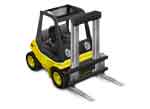Home »
Everything You Need to Know About the Knife Gate Valve
In looking at the valves to use, there are many options to select from. Check valves, simple port valves, serve as reliable devices to shut off the flow of the fluid. Butterfly valves, which consist of a rod and disc, are highly effective in regulating flow. Ball valves, with a sphere in the center, stop the flow in a system quickly and effectively.
One of the most powerful tools in the industrial world is the pneumatic knife gate valve. A powerful tool used for several purposes, the valve serves a vital role in systems where the fluid contains a high volume of suspended solids. Coming in a range of sizes with many different knife gate valve dimensions, there are many diverse forms of the valve. This valve has many advantages with only very minimal disadvantages.
What Is a Knife Gate Valve
A pneumatic knife gate valve is, in the simplest terms, a valve with a sharpened blade in the center used for cutting through thick liquids. The valve is used for shutting systems off and is not intended as a fluid regulator, though it can fill that role under certain circumstances. While pneumatic knife gate valves come in many forms, the sturdiest on the market is the stainless steel knife gate with reduced damage from corrosion.
Knife gate valves were initially devised for use in the paper pulp industry, dating back as far as 1927. The devices were created in response to the increasing need for a low-cost valve in pulp stock operations. The valves have their origins in the United States, although one of the most popular variations, the guided shear knife gate valve, was developed in Switzerland. Today, the devices are used internationally.
Knife gate valves appear in a wide variety of operations. They remain highly valued in the pulp and paper industry but have expanded significantly to appear in other industries. They’re prevalent in wastewater, where a stainless steel knife gate valve is a necessity in handling corrosive material. The valves are also used in the petroleum industry.
How Does It Work
A knife gate valve operates very simply with an actuator installed to open and shut the valve, a piston presses and lifts the blade up and down. The gate operates efficiently as the blade fully retracts in the open position, allowing a nearly complete flow. The sharp blade effectively cuts through viscous material though it requires a liquid suspension for the particles, as solid material will damage the blade.
The Types of Knife Gate Valves
There are multiple forms for this relatively simple valve. These variations include different types of blades, stems, and seats—all form solidly dependable devices.
Knife gate valves come in a wide array of materials. While stainless steel knife gate valves are preferred, other materials perform the job appreciably. Carbon steel is a highly prized choice for industrial facilities due to its high hardness and tensile value, making it ideal for high-temperature/pressure situations. Cast iron, ductile iron, and various other forms of steel are among the alternatives available.
There are different types of seats for the valve too. Metal seats have been the most traditionally used. Still, they have the limitation of impurities like sand and pebbles getting trapped in the bore of the valve, which is impossible to remove. With resilient seating, which consists of a compound in the valve, that problem is removed. If particles get trapped in the valve when it shuts, they are released when it opens again.
Finally, a knife gate valve has two different types of stems. Both are threaded stems that connect to the actuator. The first is a rising stem connecting to the gate, which rises and falls with the gate. This provides a visual sign of where the gate is as the actuator rotates around it. In a non-rising stem, the gate’s motion is concealed within the actuator and rises and requires a visual indicator to show the position of the gate. These are common underground.
The Problem of Water Hammer
The biggest problem knife gate valves face is the susceptibility to water hammer, which occurs when a pressure surge hits a hydraulic system. This happens when there’s a sudden change in direction in the fluids, leading to intense vibrations, which can damage the system.
Water hammer is a problem for knife gate valves as they must be used either fully open or fully closed and thus not used as a pressure regulator valve like a butterfly valve unless specially designed. When in a partial state, they experience vibrations. The devices also open and close slowly to guard against this problem, avoiding creating the sudden surges that make a water hammer.
Our Knife Gate Valves
Valtorc proudly offers a wide selection of knife gate valves in various options. We offer carbon steel, cast iron, ductile steel, and stainless steel knife gate valves. For operation options, we have actuation, gearbox, and manual for your valve needs. We also offer both metal and resilient seating to suit your needs. Several knife gate valve dimensions serve every need you have, from small to large valves.
The knife gate valve is an important device. You can safely trust that we at Valtorc, a leading maker of American-made valves with 40+ years in the business, will deliver on your needs. We are available to handle any questions you may have. Reach out now!

CREDIT APPLICATION
Please fill out our credit application for purchase orders and net terms. Download here

DISTRIBUTORS WANTED
Apply to become an official protected distributor. Click here to fill out our distributor application. (Online Form)
VALVE PRODUCT CATALOG
New! Download our 2018 product overview catalog or call us to request a copy. Click here to download (PDF)
